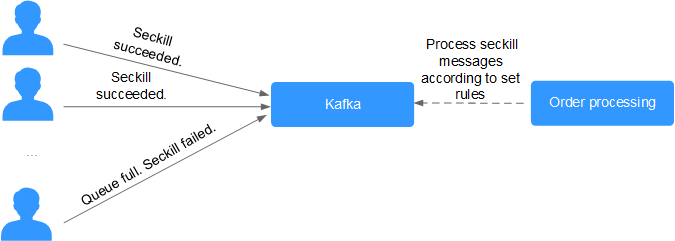Application Scenarios
Kafka is popular message-oriented middleware that features highly reliable, asynchronous message delivery. It is widely used for transmitting data between different systems in the enterprise application, payment, telecommunications, e-commerce, social networking, instant messaging, video, Internet of Things, and Internet of Vehicle industries.
Asynchronous Communication
Non-core or less important messages are sent asynchronously to receiving systems, so that the main service process is not kept waiting for the results of other systems.
For example, Kafka can be used to send a notification email and SMS message after a user has registered with a website, providing fast responses throughout the registration process.


Traffic Control
In e-commerce systems or other large-scale websites, there is a processing capability gap between upstream and downstream systems. Traffic bursts from upstream systems with high processing capabilities may have a large impact on downstream systems with low processing capabilities. For example, online sales promotions involve a huge amount of traffic flooding into e-commerce systems. DMS can help to buffer orders and other information, relieving pressure on downstream systems. It provides a three-day buffer for hundreds of millions of messages, allowing message consumption systems to process them during off-peak periods.
In addition, flash sale traffic bursts originating from frontend systems can be handled with Kafka, keeping the backend systems from crashing.

Log Synchronization
In large-scale service systems, logs of different applications are collected for quick troubleshooting, full-link tracing, and real-time monitoring.
Kafka is originally designed for this scenario. Applications asynchronously send log messages to message queues over reliable transmission channels. Other components can read the log messages from message queues for further analysis, either in real time or offline. In addition, Kafka can collect key log information to monitor applications.
- The log collection clients collect log data from a user application service and asynchronously send the log data in batches to Kafka clients.
Kafka clients receive and compress messages in batches, which only has a minor impact on the service performance.
- Kafka persists logs.
- Log processing applications, such as Logstash, subscribe to messages in Kafka and retrieve log messages from Kafka. Then, the messages are searched for by file search services or delivered to big data applications such as Hadoop for storage and analysis.


Logstash is for log analytics, ElasticSearch is for log search, and Hadoop is for big data analytics. They are all open-source tools.
Feedback
Was this page helpful?
Provide feedbackThank you very much for your feedback. We will continue working to improve the documentation.See the reply and handling status in My Cloud VOC.
For any further questions, feel free to contact us through the chatbot.
Chatbot





